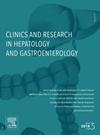Mitochondrial dysfunction in drug-induced hepatic steatosis: Recent findings and current concept
IF 2.4
4区 医学
Q2 GASTROENTEROLOGY & HEPATOLOGY
Clinics and research in hepatology and gastroenterology
Pub Date : 2025-01-09
DOI:10.1016/j.clinre.2025.102529
引用次数: 0
Abstract
Mitochondrial activity is necessary for the maintenance of many liver functions. In particular, mitochondrial fatty acid oxidation (FAO) is required for energy production and lipid homeostasis. This key metabolic pathway is finely tuned by the mitochondrial respiratory chain (MRC) activity and different transcription factors such as peroxisome proliferator-activated receptor α (PPARα). Many drugs have been shown to cause mitochondrial dysfunction, which can lead to acute and chronic liver lesions. While severe inhibition of mitochondrial FAO would eventually cause microvesicular steatosis, hypoglycemia, and liver failure, moderate impairment of this metabolic pathway can induce macrovacuolar steatosis, which can progress in the long term to steatohepatitis and cirrhosis. Drugs can impair mitochondrial FAO through several mechanisms including direct inhibition of FAO enzymes, sequestration of coenzyme A and l-carnitine, impairment of the activity of one or several MRC complexes and reduced PPARα expression. In drug-induced macrovacuolar steatosis, non-mitochondrial mechanisms can also be involved in lipid accumulation including increased de novo lipogenesis and reduced very-low-density lipoprotein secretion. Nonetheless, mitochondrial dysfunction and subsequent oxidative stress appear to be key events in the progression of steatosis to steatohepatitis. Patients suffering from metabolic dysfunction-associated steatotic liver disease (MASLD) and treated with mitochondriotoxic drugs should be closely monitored to reduce the risk of acute liver injury or a faster transition of steatosis to steatohepatitis. Therapies based on the mitochondrial cofactor l-carnitine, the antioxidant N-acetylcysteine, or thyromimetics might be useful to prevent or treat drug-induced mitochondrial dysfunction, steatosis, and steatohepatitis.
药物性肝脂肪变性的线粒体功能障碍:最新发现和当前概念。
线粒体活动是维持许多肝功能所必需的。特别是,线粒体脂肪酸氧化(FAO)是能量产生和脂质稳态所必需的。这一关键代谢途径受到线粒体呼吸链(MRC)活性和不同转录因子(如过氧化物酶体增殖物激活受体α (PPARα))的精细调节。许多药物已被证明会导致线粒体功能障碍,从而导致急性和慢性肝脏病变。虽然严重抑制线粒体FAO最终会导致微泡性脂肪变性、低血糖和肝功能衰竭,但这种代谢途径的中度损害可诱发大空泡性脂肪变性,长期发展为脂肪性肝炎和肝硬化。药物可通过多种机制损害线粒体FAO,包括直接抑制FAO酶、隔离辅酶A和左旋肉碱、损害一种或几种MRC复合物的活性以及降低PPARα的表达。在药物诱导的大空泡脂肪变性中,非线粒体机制也可参与脂质积累,包括新脂肪生成增加和极低密度脂蛋白分泌减少。然而,线粒体功能障碍和随后的氧化应激似乎是脂肪变性发展为脂肪性肝炎的关键事件。患有代谢功能障碍相关脂肪性肝病(MASLD)并接受线粒体毒性药物治疗的患者应密切监测,以减少急性肝损伤或更快地从脂肪变性转变为脂肪性肝炎的风险。基于线粒体辅助因子左旋肉碱、抗氧化剂n -乙酰半胱氨酸或促甲状腺激素的治疗可能有助于预防或治疗药物诱导的线粒体功能障碍、脂肪变性和脂肪性肝炎。
本文章由计算机程序翻译,如有差异,请以英文原文为准。
求助全文
约1分钟内获得全文
求助全文
来源期刊

Clinics and research in hepatology and gastroenterology
GASTROENTEROLOGY & HEPATOLOGY-
CiteScore
4.30
自引率
3.70%
发文量
198
审稿时长
42 days
期刊介绍:
Clinics and Research in Hepatology and Gastroenterology publishes high-quality original research papers in the field of hepatology and gastroenterology. The editors put the accent on rapid communication of new research and clinical developments and so called "hot topic" issues. Following a clear Editorial line, besides original articles and case reports, each issue features editorials, commentaries and reviews. The journal encourages research and discussion between all those involved in the specialty on an international level. All articles are peer reviewed by international experts, the articles in press are online and indexed in the international databases (Current Contents, Pubmed, Scopus, Science Direct).
Clinics and Research in Hepatology and Gastroenterology is a subscription journal (with optional open access), which allows you to publish your research without any cost to you (unless you proactively chose the open access option). Your article will be available to all researchers around the globe whose institution has a subscription to the journal.
 求助内容:
求助内容: 应助结果提醒方式:
应助结果提醒方式:


